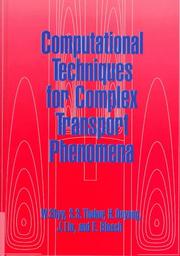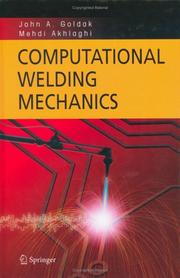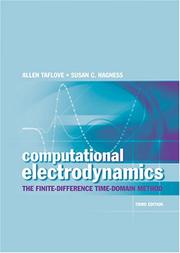| Listing 1 - 10 of 15 | << page >> |
Sort by
|
Book
ISBN: 9781934115022 9781597454407 Year: 2009 Publisher: New York : Springer,
Abstract | Keywords | Export | Availability | Bookmark
 Loading...
Loading...Choose an application
- Reference Manager
- EndNote
- RefWorks (Direct export to RefWorks)
The biological sciences are now in the midst of a true life sciences revolution akin to what physics experienced just after the turn of the last century. We are now in a phase of unparalleled growth that is reflected by the amount of data generated from each experiment. At the time of this writing, the rate of data acquisition was approaching 2 terabytes over the course of 5 days with first pass analysis proceeding over the following 2-3 week period. This fundamental shift has provided unprecedented opportunities that for the first time afford us the ability, i.e., means, breadth, and depth of data, to truly address human biology at the systems level. This wealth of information from seemingly disparate datasets and its integration is being realized through bioinformatics. It is with this philosophy that the text Bioinformatics for Systems Biology was born. This revolution has spawned true personalized medicine that encompasses diagnostics and treatment through to cure. For the physical and computer scientist, this text provides an introduction to the basic biological principles governing a cell. This quickly moves from the fundamentals to exploring the underlying genetic processes. While providing a rudimentary and necessary overview for the life scientist, the physical and computer scientist will be apprised of various nuances within the field reflecting the reality of "wet-bench" science. For those in the life sciences, it I rapidly becoming appreciated that we now progressing from examining our favorite "pet" gene to the system. Statistics is now an essential component to understand the vast datasets and this is emphasized throughout the text. The majority of the text is devoted to the common ground that these groups share. It provides rich examples of tools, databases, and strategies to mine the databases to reveal novel insights. A host of examples of parsing the data into a series of overlays that use various presentation systems are reviewed. The goal is to provide a representation most comfortable to the user to enable the user to thoroughly explore the data. The text concludes with examples of how the systems information is used to inform personalized medicine in a true "bench to bedside" manner. Bioinformatics for Systems Biology bridges and unifies many disciplines. It presents the life scientist, computational biologist, and mathematician with a common framework. Only by linking the groups together may the true life sciences revolution move forward in the mostly uncharted and emerging field of Systems Biology.
Bioinformatics --- Systems biology --- Computational biology --- Cytology --- Data processing. --- Bioinformatique --- Cytologie --- Traitement des données
Book
ISBN: 9780415816625 9780415816632 9780415816649 9780415816656 9780415816663 0415816645 Year: 2020 Publisher: Abingdon, Oxon ; New York : Routledge,
Abstract | Keywords | Export | Availability | Bookmark
 Loading...
Loading...Choose an application
- Reference Manager
- EndNote
- RefWorks (Direct export to RefWorks)
'Digital architecture' is a relatively recent critical concept and encompasses all aspects of the discipline of architecture engaging with computation. It has evolved into a domain in its own right, as it were, rather than always being present from the first time architects ceded slide rule use in favour of electronically assisted computation. As this major collection reveals, we have witnessed growth of a creative digital influence across all of architecture's subdisciplines and few can deny that there is now a maturity in the conversation which had been previously quite elusive. As a major work of collected critical insights Digital Architecture therefore compiles the key texts that will be as useful to the initiate as to the experienced professional, as relevant to the academician as to the practitioner and as revealing to the sceptic as they will be to the digitally converted. It does not promote any particular stream of innovation nor establish any particular cultural agenda. The focus of the collection is the contemporary period extending from the late 1980s to the present day contextualised through the inclusion of key texts from the earlier pioneers, ordered into six sections. Each section is arranged in chronological order except where thematic clustering helps consolidate the material more usefully for the reader. A review of the best material that has brought us to an emerging digital design maturity, fully indexed, this will be a very valuable reference for all.
Architecture --- Design architectural --- Innovations technologiques. --- Traitement des données. --- Architectural design --- Data processing --- Informatique --- Traitement des données.
Book
ISBN: 9789463561471 Year: 2019 Publisher: Culemborg Van Duuren Informatica
Abstract | Keywords | Export | Availability | Bookmark
 Loading...
Loading...Choose an application
- Reference Manager
- EndNote
- RefWorks (Direct export to RefWorks)
Uit onderzoek blijkt dat 40% van de mensen slechts twee tot vier verschillende wachtwoorden gebruikt. 10% gebruikt zelfs maar één wachtwoord voor álle accounts. Bijna de helft van de mensen wijzigt het wachtwoord niet eens als het gehackt is.Als je wachtwoord dan op straat komt te liggen, is het kinderspel voor een crimineel om zich op meerdere plekken als jou voor te doen. Daarmee geef je criminelen de kans vrienden en familie te beduvelen. En je brengt je bedrijf in gevaar - meer dan 80% van de datalekken zijn terug te voeren naar wachtwoorden zie zwak of hergebruikt zijn.Al jaren zijn er geluiden dat wachtwoorden binnenkort verleden tijd zijn. Wachtwoorden zijn echter goed ingeburgerd en blijven nog wel even. Je kunt beter orde op zaken stellen en je digitale weerbaarheid vergroten. De oplossing is al jaren onder handbereik: het is tijd om een wachtwoordmanager te omarmen. Als je eenmaal een wachtwoordmanager gebruikt is het minder werk én veiliger dan andere werkwijzen om wachtwoorden te onthouden.Dit boek geeft je achtergrondinformatie over het waarom van een wachtwoordmanager. Inloggen op een wachtwoordmanager is zo gebeurd. Zeker op een smartphone, tablet of moderne computer waar je kunt inloggen met een vingerafdruk of gezichtsherkenning.Als je al overtuigd bent van het nut van een wachtwoordmanager kun je direct door naar de hoofdstukken over de installatie en het gebruik van Bitwarden.Bron : http://www.managementboek.nl
681.324 --- Internet --- Cybercrime --- Wachtwoorden --- Computernetwerken --- Beveiliging --- Computercriminaliteit --- Informatietechnologie --- Informatique et traitement des données --- criminalité informatique --- Conceptcomputercriminaliteit --- Informatica en gegevensverwerking --- Computer architecture. Operating systems --- internet --- computerbeveiliging --- computercriminaliteit --- IT --- Informatique et traitement des données --- criminalité informatique
Book
ISBN: 9781420072754 1420072757 Year: 2009 Publisher: Boca Raton : CRC Press,
Abstract | Keywords | Export | Availability | Bookmark
 Loading...
Loading...Choose an application
- Reference Manager
- EndNote
- RefWorks (Direct export to RefWorks)
Finite element method --- C (Computer program language) --- Éléments finis, méthode des --- C (langage de programmation) --- Data processing. --- Logiciels --- MATLAB. --- Éléments finis, méthode des --- C (langage de programmation) --- Logiciels --- Traitement des données
Book
ISBN: 9780131362178 0131362178 Year: 2009 Publisher: New York London : Pearson Education International,
Abstract | Keywords | Export | Availability | Bookmark
 Loading...
Loading...Choose an application
- Reference Manager
- EndNote
- RefWorks (Direct export to RefWorks)
With a hands-on approach and focus on problem solving, this introduction to the powerful Matlab computing language is designed for students with only a basic college algebra background. Numerous examples are drawn from a range of engineering disciplines, demonstrating Matlab's applications to a broad variety of problems.
Engineering mathematics --- Numerical analysis --- Data processing. --- MATLAB. --- 519.6 --- 681.3*D3 --- Computational mathematics. Numerical analysis. Computer programming --- Programming languages --- Matlab --- Matlab. --- 681.3*D3 Programming languages --- 519.6 Computational mathematics. Numerical analysis. Computer programming --- Matlab (logiciel) --- Mathématiques de l'ingénieur --- Analyse numérique --- Traitement des données

ISBN: 0521592682 Year: 1997 Publisher: Cambridge Cambridge University press
Abstract | Keywords | Export | Availability | Bookmark
 Loading...
Loading...Choose an application
- Reference Manager
- EndNote
- RefWorks (Direct export to RefWorks)
Computational fluid dynamics. --- Multiphase flow --- Turbulence --- Transport theory --- Mathematical models. --- Fluid dynamics --- #KVIV:BB --- CFD (Computational fluid dynamics) --- Data processing --- Mathematical models --- Computer simulation --- Data processing. --- Mathematical mocels. --- Dynamique des fluides --- Écoulement polyphasique --- Théorie du transport --- Traitement des données --- Modèles mathématiques --- Écoulement polyphasique --- Théorie du transport --- Traitement des données --- Modèles mathématiques

ISBN: 1280618566 9786610618569 0387232885 0387232877 1441935991 Year: 2005 Publisher: New York : Springer,
Abstract | Keywords | Export | Availability | Bookmark
 Loading...
Loading...Choose an application
- Reference Manager
- EndNote
- RefWorks (Direct export to RefWorks)
Computational Welding Mechanics (CWM) provides readers with a complete introduction to the principles and applications of computational welding including coverage of the methods engineers and designers are using in computational welding mechanics to predict distortion and residual stress in welded structures, thereby creating safer, more reliable and lower cost structures. Drawing upon years of practical experience and the study of computational welding mechanics the authors instruct the reader how to: - understand and interpret computer simulation and virtual welding techniques including an in depth analysis of heat flow during welding, microstructure evolution and distortion analysis and fracture of welded structures, - relate CWM to the processes of design, build, inspect, regulate, operate and maintain welded structures, - apply computational welding mechanics to industries such as ship building, natural gas and automobile manufacturing. Ideally suited for practicing engineers and engineering students, Computational Welding Mechanics is a must-have book for understanding welded structures and recent technological advances in welding, and it provides a unified summary of recent research results contributed by other researchers.
Welding --- Metal-work --- Data processing. --- Forging --- Manufacturing processes --- Sealing (Technology) --- Mechanical engineering. --- Engineering. --- Industrial engineering. --- Mechanical Engineering. --- Machinery and Machine Elements. --- Industrial and Production Engineering. --- Management engineering --- Simplification in industry --- Engineering --- Value analysis (Cost control) --- Construction --- Industrial arts --- Technology --- Engineering, Mechanical --- Machinery --- Steam engineering --- Machinery. --- Production engineering. --- Manufacturing engineering --- Process engineering --- Industrial engineering --- Mechanical engineering --- Machines --- Manufactures --- Power (Mechanics) --- Motors --- Power transmission --- Curious devices --- Soudage --- Traitement des données --- Traitement des données
Periodical
Abstract | Keywords | Export | Availability | Bookmark
 Loading...
Loading...Choose an application
- Reference Manager
- EndNote
- RefWorks (Direct export to RefWorks)
Accounting --- Business --- Expert systems (Computer science) --- Artificial intelligence --- Comptabilité --- Gestion --- Systèmes experts (Informatique) --- Intelligence artificielle --- Artificial intelligence. --- Gestion. --- Intelligence artificielle. --- Traitement des données. --- Système expert. --- Data processing --- Informatique --- Data processing. --- Knowledge-based systems (Computer science) --- Systems, Expert (Computer science) --- Electronic data processing --- AI (Artificial intelligence) --- Artificial thinking --- Electronic brains --- Intellectronics --- Intelligence, Artificial --- Intelligent machines --- Machine intelligence --- Thinking, Artificial --- Automated accounting systems --- Computerized accounting systems --- Machine accounting --- Artificial Intelligence. --- Accounting & Tax. --- Computer systems --- Soft computing --- Bionics --- Cognitive science --- Digital computer simulation --- Logic machines --- Machine theory --- Self-organizing systems --- Simulation methods --- Fifth generation computers --- Neural computers --- Comptabilité --- Systèmes experts (Informatique) --- Traitement des données. --- Système expert. --- Taxes --- Accountancy

ISBN: 1580538320 9781580538329 Year: 2005 Publisher: Norwood : Artech House, Inc.,
Abstract | Keywords | Export | Availability | Bookmark
 Loading...
Loading...Choose an application
- Reference Manager
- EndNote
- RefWorks (Direct export to RefWorks)
Quantum mechanics. Quantumfield theory --- Electromagnetism. Ferromagnetism --- Information systems --- Electromagnetism --- Maxwell equations --- Moments method (Statistics) --- Integro-differential equations --- Numerical solutions --- Data processing --- EMC --- elektromagnetisme --- 519.63 --- 681.3*G18 --- 537.8 --- -Maxwell equations --- -Moments method (Statistics) --- Method of moments (Statistics) --- Mathematical statistics --- Distribution (Probability theory) --- Equations, Maxwell --- Differential equations, Partial --- Electromagnetic theory --- Integrodifferential equations --- Differential equations --- Integral equations --- Electromagnetics --- Magnetic induction --- Magnetism --- Metamaterials --- Numerical methods for solution of partial differential equations --- Partial differential equations: difference methods; elliptic equations; finite element methods; hyperbolic equations; method of lines; parabolic equations (Numerical analysis) --- Electromagnetism. Electromagnetic field. Electrodynamics. Maxwell theory --- 537.8 Electromagnetism. Electromagnetic field. Electrodynamics. Maxwell theory --- 681.3 *G18 Partial differential equations: difference methods; elliptic equations; finite element methods; hyperbolic equations; method of lines; parabolic equations (Numerical analysis) --- 519.63 Numerical methods for solution of partial differential equations --- Numerical analysis --- 681.3 *G18 --- Moments, Méthodes des (statistique) --- Maxwell, Équations de --- Électromagnétisme. --- Data processing. --- Solutions numériques --- Traitement des données. --- Maxwell equations - Numerical solutions --- Maxwell equations - Data processing --- Integro-differential equations - Numerical solutions --- Moments, Méthodes des (statistique) --- Maxwell, Équations de --- Électromagnétisme. --- Solutions numériques --- Traitement des données.
Book

ISBN: 9789403008196 9403008199 Year: 2019 Volume: 2018(6) Publisher: Liège Wolters Kluwer
Abstract | Keywords | Export | Availability | Bookmark
 Loading...
Loading...Choose an application
- Reference Manager
- EndNote
- RefWorks (Direct export to RefWorks)
Partie I. Cadre théorique et textes fondateurs : I. Le droit au respect de la vie privée - II. Les traitements de données à caractère personnel - III. Le droit à la liberté d'expression - Partie II. Aspects pratiques : I. Le recrutement du travailleur et la conclusion du contrat de travail - II. L'exécution du contrat de travail - III. La rupture du contrat de travail - IV. Les sanctions d'une violation de la vie privée du travailleur - Bibliographie - Sources
Social law. Labour law --- Belgium --- GDPR --- protection des données --- privacy --- belgique --- personeelsbeleid --- ontslag --- bien-être --- RGPD --- gegevensbescherming --- belgie --- gestion du personnel --- licenciement --- welzijn --- Protection de l'information (informatique) --- Travail et vie personnelle --- Employeur et employé (droit) --- Internet en milieu de travail --- Droit à la vie privée --- Droit --- Union européenne. Règlement (UE) 2016/679 du Parlement européen et du Conseil du 27 avril 2016 relatif à la protection des personnes physiques à l'égard du traitement des données à caractère personnel et à la libre circulation de ces données, et abrogeant la directive 95/46/CE (règlement général sur la protection des données) --- Labor contract --- Privacy, Right of --- Labor laws and legislation --- Industrial relations --- Contrat de travail --- Travail --- Relations industrielles --- Law and legislation --- Data processing --- Electronic data processing --- Data protection --- Algemene juridische begrippen : Privacy --- Notions juridiques générales : Vie privée --- E-books --- Union européenne. Règlement (UE) 2016/679 du Parlement européen et du Conseil du 27 avril 2016 relatif à la protection des personnes physiques à l'égard du traitement des données à caractère personnel et à la libre circulation de ces données, et abrogeant la directive 95/46/CE (règlement général sur la protection des données) --- Belgique --- Protection de l'information (Informatique)
| Listing 1 - 10 of 15 | << page >> |
Sort by
|

 Search
Search Feedback
Feedback About UniCat
About UniCat  Help
Help News
News